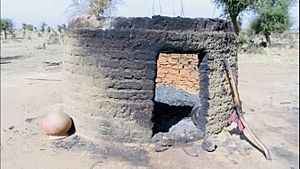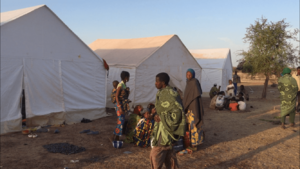Jihadist insurgency in Burkina Faso facts for kids
Quick facts for kids Jihadist insurgency in Burkina Faso |
|||||||||
|---|---|---|---|---|---|---|---|---|---|
| Part of the Islamist insurgency in the Sahel and the spillover of the Mali War | |||||||||
 Smoke rising from French Embassy in Ouagadougou, 2 March 2018, during the 2018 Ouagadougou attacks. |
|||||||||
|
|||||||||
| Belligerents | |||||||||
Supported by:
|
|
||||||||
| Commanders and leaders | |||||||||
|
|||||||||
| Casualties and losses | |||||||||
|
2.06 million displaced |
|||||||||
Since August 2015, the country of Burkina Faso has been facing an ongoing conflict. This conflict is between the government of Burkina Faso and different armed groups. It has caused many people to leave their homes and has led to the deaths of thousands of people.
This conflict in Burkina Faso is part of a larger problem in the Sahel region of Africa. The Sahel is a wide strip of land just south of the Sahara Desert.
Contents
What Caused the Conflict?
For a long time, Burkina Faso was led by President Blaise Compaoré. He was president from 1987 to 2014. During his time, his government sometimes worked with certain armed groups to free people who had been taken hostage.
Burkina Faso also tried to help solve problems in the nearby country of Mali, which was also dealing with conflict. However, in November 2014, President Compaoré was removed from power. This event created a period of instability in Burkina Faso, which means the country became less stable and more unpredictable.
Key Events in the Conflict
Early Attacks and Expansion
The conflict began on August 23, 2015, when an attack happened on a police station. Between 2015 and 2016, several more attacks took place across the country. These attacks caused deaths and injuries.
On January 15, 2016, the capital city, Ouagadougou, was attacked. Thirty people were killed. Two different armed groups said they were responsible for this attack.
In 2017, security forces killed Harouna Dicko, a leader of one of the armed groups. Later that year, another leader from the same group, Ibrahim Malam Dicko, was also killed. A new leader, Jafar Dicko, then took over the group.
Between March and April 2017, the armies of Mali, France, and Burkina Faso worked together in an operation called "Operation Panga." About 1,300 soldiers searched a forest near the border with Mali.
In 2018, the conflict spread to the eastern part of Burkina Faso. The country's army, with help from French forces, started a big military operation there.
Growing Violence and Displacements
From mid-2018 to early 2019, many people were killed in violent events. Some were killed by armed groups, and others were killed by military forces. In March and April 2019, fighting between different ethnic groups in a town called Arbinda led to 62 deaths.
In May 2019, French forces attacked an armed group's camp. They rescued four people who had been taken hostage: two from France, one from South Korea, and one from the United States. During this operation, four members of the armed group and two French soldiers died.
Despite efforts to stop the violence, attacks became more common. In 2019, violence in Burkina Faso increased a lot. Almost 1,300 civilians died, and 860,000 people had to leave their homes.
Changes in Leadership
On January 23, 2022, military officers took over the government. This is called a coup d'état. Many people supported this change because they felt the government was not doing enough to stop the armed groups. The new military leader, Paul-Henri Sandaogo Damiba, was known for his military actions against these groups. He also changed some government leaders.
In June 2022, an organization called ECOWAS (Economic Community of West African States) said that the government of Burkina Faso controlled about 60% of the country.
The government also announced "military zones" in June 2022. People living in these areas were told to leave their homes so the army could fight the armed groups more easily. They were given two weeks to move to safer places.
On September 30, 2022, another military coup happened. This was the second coup in less than a year. The military removed Paul-Henri Damiba from power. They said he was not able to deal with the armed groups. The new leader was Colonel Ibrahim Traoré. He had led a special unit fighting these groups in the north of Burkina Faso.
On October 2, 2022, religious and community leaders helped mediate between Damiba and Traoré. Damiba agreed to step down. He asked for certain promises, like protection for his allies and his own safety. He also asked that the new leaders keep the promise to ECOWAS about returning to civilian rule in two years.
Impact on People
The conflict has caused a serious humanitarian crisis. This means that many people are suffering and need help. Thousands of people have been killed, and millions have been forced to leave their homes. The United Nations says that most of the people who have been displaced in the Sahel region are from Burkina Faso.
See also
 In Spanish: Insurgencia islamista en Burkina Faso para niños
In Spanish: Insurgencia islamista en Burkina Faso para niños
- Jihadist insurgency in Niger





